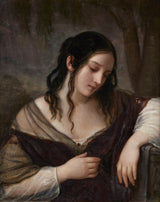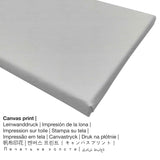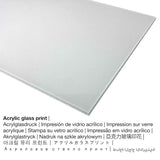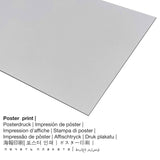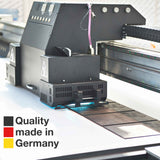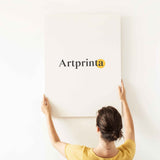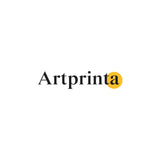Ozi izizi banyere ọrụ nka sitere na Belvedere (© Nwebiisinka - Belvedere - www.belvedere.at)
Natale Schiavoni, who once "il pittore delle grazie" was called, that reputation was primarily for his depictions of women. In addition, his oeuvre includes numerous portraits, religious subjects and historical genre scenes. After first attempts as an engraver he turned the miniature painting, worked since 1807 at the court of the viceroy of Italy in Milan and was established in 1816 by Emperor Franz to Vienna. He portrayed the members of the imperial family and the aristocracy and enjoyed high reputation (sustainable appreciation Emperor Franz I commented later in the purchase of the 1,832 issued in the Brera in Milan picture "The Penitent Mary Magdalene" for the imperial art collection. The work was discussed in the contemporary press in long treatises and took place in autumn 1836 at the reopening of the Art Gallery in the Upper Belvedere lineup. Today it is owned by the Austrian Gallery Belvedere). 1821 Schiavoni left with his family (his sons Felice and Giovanni were also a painter) settled in Venice. The image formats were from now larger, the range of topics wider. Late thirties, beginning with the presentation Malinconia (Melancholy, 1837, Milan, Galleria d'Arte Moderna), the painter employed reinforced with the pictorial implementation of allegorical terms such as "seduction", "temptation", "evil", " List "," first love ", etc. As a medium for the clarification he preferred the female half-length piece. The audience these representations were well received, less, however, in the press, which accused him penchant for decorative and Spruce, drawing incorrectness and repeating already found ideas. This image is titled The sadness. is typical of Schiavoni that he needs no explanatory Beiwerkes expressed the state of mind. The woman alone is sufficient, their posture, inclination of the head and the pose of the hands. The black, tüllartige scarf bare shoulders partially covered, and the weeping willow in the background have only underlining function. Museo Civico P. Revoltella in Trieste there is an almost equal representation, which was made in the previous year; Differences are only in detail, in the hairstyle, the position of the veil, the clothes (the Vienna picture shows in cutting a lapel pin), but above all in the background, the picture is just a generously draped curtain in Trieste. In comparison, the Vienna image appears delicate painted and intimate expression, the pain of the woman is formulated ideal type by complementing the weeping willow. [Source: Grabner, Sabine: Natale Schiavoni. The sadness in: New Acquisitions. Master of Heiligenkreuz to Krystufek, exh. Cat. Osterreichische Galerie Belvedere, Vienna 15.09.-21.11.1999 (temporary exhibition of the Austrian Gallery, 224), S. 40f]
Data ndabere gbasara nka
| Aha eserese ahụ: | "Sadness" |
| Nhazi nka: | sere |
| Otu sara mbara: | nkà nke oge a |
| Nhazi oge: | 19th narị afọ |
| Emepụtara na: | 1841 |
| Afọ nka: | 170 afọ |
| Ihe osise izizi: | mmanụ na kwaaji |
| Nha izizi (ọrụ nka): | 73 x 59 cm |
| Akara mbinye aka: | signed and dated lower right: N. Schiavoni / 1841 |
| Egosiputara na: | Belvedere |
| Ebe ebe ngosi nka: | Vienna, Austria |
| website: | Belvedere |
| Ikikere nke ihe osise: | ngalaba ọha |
| Site n'aka: | © Belvedere, Vienna, nọmba ngwa ahịa: 8956 |
| Ebe kredit nke ọrụ nka: | zụta site na Dorotheum, Vienna na 1994 |
Nchịkọta dị mkpirikpi nke onye na-ese ihe
| aha: | Natale Shiavone |
| Ọrụ: | onye na-ese ihe |
| Otu nka: | omenkà nke oge a |
| Ụdị nka: | Ihe ngosi |
| Oge ndu: | 81 afọ |
| Amụrụ n'afọ: | 1777 |
| Obodo ọmụmụ: | Chioggia, Veneto |
| Afọ nwụrụ: | 1858 |
| Nwuru na (ebe): | Venice |
Banyere edemede a
| Nkewa bipụta: | nka nka |
| Usoro mmeputakwa: | dijitalụ mmeputakwa |
| Produzọ mmepụta: | mbipụta dijitalụ |
| Production: | German mmepụta |
| Stockdị ngwaahịa: | mmepụta ihe na-achọ |
| Ojiji ngwaahịa: | ihe ndozi ụlọ, ụlọ ihe osise nka |
| Ndozi onyonyo a: | usoro eserese |
| Ụdị anya: | 1: 1.2 (ogologo: obosara) |
| Mmetụta nke akụkụ akụkụ: | ogologo bụ 20% mkpụmkpụ karịa obosara |
| Akụrụngwa dị: | ígwè obibi akwụkwọ (aluminium dibond), akwụkwọ mmado (akwụkwọ kwaaji), mbipụta enyo acrylic (nke nwere ezigbo mkpuchi iko), mbipụta akwụkwọ. |
| Nhọrọ nha nha mbipụta kanvas (akwa akwa na etiti ihe ndọtị): | 50x60cm - 20x24", 100x120cm - 39x47", 150x180cm - 59x71" |
| Acrylic glass print (nwere ezigbo mkpuchi iko) nhọrọ: | 50x60cm - 20x24", 100x120cm - 39x47", 150x180cm - 59x71" |
| Mbipụta akwụkwọ mmado (akwụkwọ kwaaji): | 50x60cm - 20x24", 100x120cm - 39x47" |
| Nhọrọ nha mbipụta aluminom: | 50x60cm - 20x24", 100x120cm - 39x47" |
| Nhazi nke nnomi nka: | enweghị etiti |
Họrọ ngwa ngwaahịa masịrị gị
Anyị na-enye ihe dị iche iche dị iche iche na nha maka ngwaahịa ọ bụla. Ka ị kwekọọ n'ihe ị chọrọ nke ọma, ị nwere ike họrọ n'ime nhọrọ nhazi ngwaahịa ndị a:
- Mbipụta kanvas: A canvas print, which should not be confused with a canvas painting, is a digital copy applied onto cotton canvas material. Further, a canvas creates a nice and comfortable feeling. Your canvas of your favorite artwork will allow you to transform your custom art print into a large size artpiece. Canvas prints are relatively low in weight, which means that it is easy to hang up the Canvas print without the help of extra wall-mounts. That is why, canvas prints are suited for any type of wall.
- Aluminom ihe eji eme ihe: These are metal prints on aluminium dibond material with a true depth effect. For our Direct Print On Aluminum Dibond, we print the chosen artpiece on the surface of the white-primed aluminum material. The direct print on Aluminum Dibond is one of the most demanded entry-level products and is a truly sophisticated way to showcase fine art reproductions, since it puts all of the viewer’s attention on the artwork.
- Mbipụta akwụkwọ mmado (ihe kwaaji): The poster is a UV printed flat canvas with a slightly roughened texture on the surface, which resembles the original masterpiece. Please bear in mind, that depending on the size of the poster print we add a white margin between 2-6cm round about the painting, which facilitates the framing with your custom frame.
- Mbipụta iko acrylic (nke nwere ezigbo mkpuchi iko): The print on acrylic glass, which is sometimes labelled as a an art print on plexiglass, will change an original artwork into beautiful wall décor.
Ozi ndabere na akụkọ
Ihe osise narị afọ nke 19 akpọrọ mwute onye omenkà mere ya Natale Shiavone. The original version has the exact dimensions of 73 x 59 cm na arụpụtara ya na Usoro oil on canvas. "Signed and dated lower right: N. Schiavoni / 1841" is the masterpiece's original inscription. What is more, the work of art is included in the nke Belvedere digital art collection, which is one of Europe's most famous museums with three locations that blends the experience of architecture and art in a unique way. The modern art masterpiece, which belongs to the ngalaba ọha is being provided with courtesy of © Belvedere, Vienna, inventory number: 8956. Creditline of the artwork: zụta site na Dorotheum, Vienna na 1994. N'elu nke ahụ, nhazi nke mmepụta dijitalụ na-abanye Eserese format na akụkụ ruru nke 1: 1.2, meaning that the length is 20% shorter than the width. The painter Natale Schiavone was an artist, whose style can be attributed primarily to Realism. The artist lived for a total of 81 afọ, born in the year 1777 in Chioggia, Veneto and passed away in the year 1858 in Venice.
Ozi dị mkpa: We try the best we can to depict our art products as accurate as possible and to exhibit them visually in our shop. Nevertheless, the colors of the print products and the printing may vary to a certain extent from the representation on the screen. Depending on your screen settings and the nature of the surface, colors can unfortunately not be printed one hundret percent realistically. In view of the fact that all the fine art prints are processed and printed manually, there might as well be minor deviations in the exact position and the size of the motif.
Edobere ederede a site na nwebisiinka © - www.artprinta.com (Artprinta)

